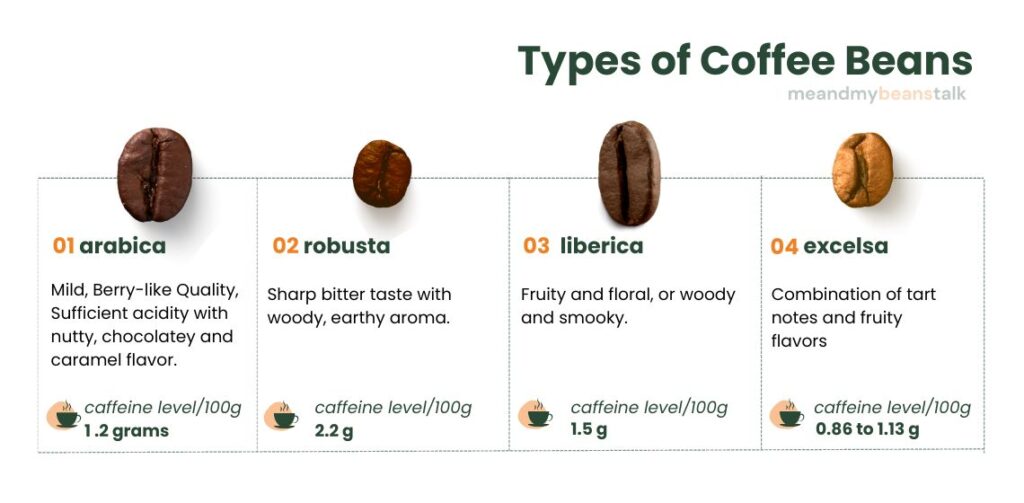Types of coffee beans
There are four types of coffee beans: Arabica, Robusta, Liberica, and Excelsa. Among the four varieties, arabica and robusta are the most well-known.
Coffee characteristics are measured by the quality of the bean and the intensity of flavor, aroma, acidity, and taste (body) mild or bold.


Arabica
Arabica coffee beans have a smoother, sweeter, and more nuanced flavor than other coffee types, with notes of fruit, chocolate, nuts, and caramel. They are also lower in caffeine and more acidic, making them less bitter and easier to drink.
Arabica beans are the most widely consumed coffee beans worldwide, making up approximately 60% of the globally produced coffee. It is believed to be among the very first coffee beans ever consumed. That was first cultivated in the highlands of Ethiopia centuries ago.
However, they are more challenging to cultivate compared to other coffee beans. Arabica beans need extra shade, water, and a high altitude of at least 2,000 feet to grow properly. This makes them more expensive.
Robusta
Robusta coffee beans are the second most common type of coffee, accounting for around 40% of coffee production. The plants earn their name due to being hardier than Arabica plants, having reduced susceptibility to disease, and thriving in diverse environments, including low altitudes.
Robusta beans are smaller, and rounder and have a higher concentration of caffeine than Arabica beans. Robusta coffee has many unidentified heirloom varieties, but you can categorize them into Erecta (upright varieties) or Nganda (spreading varieties). The flavor profile is dark and earthy and can have bitter or burnt flavors. Although it is considered inferior to Arabica, it can add complexity when used as an Arabica-Robusta blend.
Liberica
Liberica coffee beans, also known as Coffea liberica, is a distinct and less common species of coffee beans. It originated in Liberia and is primarily cultivated in Southeast Asian countries like the Philippines, Malaysia, and Indonesia. Liberica beans are known for their bold, full-bodied flavor with woody and smoky undertones, accompanied by a unique aroma that can be described as floral or fruity. The beans are large and irregularly shaped, often exhibiting a “peaberry” appearance. Liberica coffee faces cultivation challenges due to its susceptibility to diseases and pests, requiring specific climatic conditions for successful growth. Although less prevalent in the global coffee market compared to Arabica and Robusta, Liberica beans are sought after by those seeking a distinct and uncommon coffee experience.
Excelsa
Excelsa coffee beans were once considered a different type of coffee but have now been reclassified as a subtype of Liberia. Like other Liberica coffees, it grows on tall trees rather than shrubs.
Excelsa coffee offers coffee enthusiasts an intriguing taste experience with its distinctive flavor profile. While not as widely known or cultivated as Arabica and Robusta, Excelsa beans provide an opportunity for coffee lovers to explore different flavors and expand their coffee palate.


Pingback: All about Arabica Beans - Me and My Beans Talk
Comments are closed.